Bibliometrics-Based: Trends in Phytoremediation of Potentially Toxic Elements in Soil
Abstract
:1. Introduction
2. Materials and Methods
2.1. Data Sources
2.2. Research Technique
3. Result
3.1. Distribution of Time
- Steady stage (2008–2013)
- 2.
- Gradual improvement stage (2014–2018)
- 3.
- Rapid development stage (2019–now)
3.2. Important Sources of Literature
3.3. Main Research Strength
3.3.1. Analysis of Publishing Countries
3.3.2. Analysis of Major Research Institutions
3.4. Keywords Collinear Network
4. Conclusions and Discussion
Conclusions
- Returning farmland to forest, using perennial non-edible plants to repair soil potentially polluted by toxic elements (for example, the use of trees as vegetation cover). The roots and stems of trees are more developed and resistant, and they can survive in harsh environmental conditions [39].
- Plant–bacteria interaction for remediation of contaminated soil. Plant nodules can be used to remove potentially toxic elements from the soil, and aquatic plant roots can also remove potentially toxic elements from polluted waters [40].
- Cultivate plants that can absorb toxic elements, have strong stress resistance, and can adapt to local conditions. Because of global warming, it is necessary to cultivate transgenic plants that can maintain good phytoremediation ability under high temperatures, to cope with the pollution of toxic elements in high-emitting industrial areas [41].
- Soil pollution in China is mainly caused by toxic elements and metalloids, of which farmland soil pollution accounts for 19%. The phenomenon of potentially toxic element pollution in southern China is rapidly increasing; therefore, it is necessary to increase the remediation of soil pollution, or change the use of soil to stop planting food crops [42].
- Most studies in Pakistan are conducted on the remediation of single potentially toxic elements such as Cd and arsenic. Currently, the focus is on using microorganisms and chelates combined with plants for the remediation of soil’s potentially toxic elements, in the hopes of finding a comprehensive removal method for various potentially toxic elements [47].
- Countries such as France, Brazil, Poland, and Belgium need to strengthen their cooperation with other countries.
5. Outlook
Author Contributions
Funding
Data Availability Statement
Conflicts of Interest
References
- Shikha, D.; Singh, P.K. In situ phytoremediation of heavy metal-contaminated soil and groundwater: A green inventive approach. Environ. Sci. Pollut. Res. Int. 2021, 28, 4104–4124. [Google Scholar] [CrossRef] [PubMed]
- Leal Filho, W.; Dedeoglu, C.; Dinis, M.A.P.; Salvia, A.L.; Barbir, J.; Voronova, V.; Abubakar, I.R.; Iital, A.; Pachel, K.; Huthoff, F.; et al. Riverine Plastic Pollution in Asia: Results from a Bibliometric Assessment. Land 2022, 11, 1117. [Google Scholar] [CrossRef]
- Gavrilescu, M. Enhancing phytoremediation of soils polluted with heavy metals. Curr. Opin. Biotechnol. 2022, 74, 21–31. [Google Scholar] [CrossRef] [PubMed]
- Gao, J.; Faheem, M.; Yu, X. Global Research on Contaminated Soil Remediation: A Bibliometric Network Analysis. Land 2022, 11, 1581. [Google Scholar] [CrossRef]
- Wei, Z.; Van Le, Q.; Peng, W.; Yang, Y.; Yang, H.; Gu, H.; Lam, S.S.; Sonne, C. A review on phytoremediation of contaminants in air, water and soil. J. Hazard. Mater. 2021, 403, 123658. [Google Scholar] [CrossRef]
- Wu, B.; Peng, H.; Sheng, M.; Luo, H.; Wang, X.; Zhang, R.; Xu, F.; Xu, H. Evaluation of phytoremediation potential of native dominant plants and spatial distribution of heavy metals in abandoned mining area in Southwest China. Ecotoxicol. Environ. Saf. 2021, 220, 112368. [Google Scholar] [CrossRef]
- Bian, F.; Zhong, Z.; Li, C.; Zhang, X.; Gu, L.; Huang, Z.; Gai, X.; Huang, Z. Intercropping improves heavy metal phytoremediation efficiency through changing properties of rhizosphere soil in bamboo plantation. J. Hazard. Mater. 2021, 416, 125898. [Google Scholar] [CrossRef]
- Su, R.; Wang, Y.; Huang, S.; Chen, R.; Wang, J. Application for Ecological Restoration of Contaminated Soil: Phytoremediation. Int. J. Environ. Res. Public Health 2022, 19, 13124. [Google Scholar] [CrossRef]
- Sabreena; Hassan, S.; Bhat, S.A.; Kumar, V.; Ganai, B.A.; Ameen, F. Phytoremediation of Heavy Metals: An Indispensable Contrivance in Green Remediation Technology. Plants 2022, 11, 1255. [Google Scholar] [CrossRef]
- Ubando, A.T.; Africa, A.D.M.; Maniquiz-Redillas, M.C.; Culaba, A.B.; Chen, W.H.; Chang, J.S. Microalgal biosorption of heavy metals: A comprehensive bibliometric review. J. Hazard. Mater. 2021, 402, 123431. [Google Scholar] [CrossRef]
- Doumett, S.; Lamperi, L.; Checchini, L.; Azzarello, E.; Mugnai, S.; Mancuso, S.; Petruzzelli, G.; Del Bubba, M. Heavy metal distribution between contaminated soil and Paulownia tomentosa, in a pilot-scale assisted phytoremediation study: Influence of different complexing agents. Chemosphere 2008, 72, 1481–1490. [Google Scholar] [CrossRef] [PubMed]
- Ren, W.-X.; Li, P.-J.; Geng, Y.; Li, X.-J. Biological leaching of heavy metals from a contaminated soil by Aspergillus niger. J. Hazard. Mater. 2009, 167, 164–169. [Google Scholar] [CrossRef] [PubMed]
- Wu, L.; Li, Z.; Han, C.; Liu, L.; Teng, Y.; Sun, X.; Pan, C.; Huang, Y.; Luo, Y.; Christie, P. Phytoremediation of Soil Contaminated with Cadmium, Copper and Polychlorinated Biphenyls. Int. J. Phytoremediation 2012, 14, 570–584. [Google Scholar] [CrossRef] [PubMed]
- Chang, F.-C.; Ko, C.-H.; Tsai, M.-J.; Wang, Y.-N.; Chung, C.-Y. Phytoremediation of heavy metal contaminated soil by Jatropha curcas. Ecotoxicology 2014, 23, 1969–1978. [Google Scholar] [CrossRef] [PubMed]
- Bang, J.; Kamala-Kannan, S.; Lee, K.-J.; Cho, M.; Kim, C.-H.; Kim, Y.-J.; Bae, J.-H.; Kim, K.-H.; Myung, H.; Oh, B.-T. Phytoremediation of Heavy Metals in Contaminated Water and Soil UsingMiscanthussp. Goedae-Uksae 1. Int. J. Phytoremediation 2014, 17, 515–520. [Google Scholar] [CrossRef] [PubMed]
- Sanz-Fernandez, M.; Rodriguez-Serrano, M.; Sevilla-Perea, A.; Pena, L.; Mingorance, M.D.; Sandalio, L.M.; Romero-Puertas, M.C. Screening Arabidopsis mutants in genes useful for phytoremediation. J. Hazard. Mater. 2017, 335, 143–151. [Google Scholar] [CrossRef]
- Basu, S.; Rabara, R.C.; Negi, S.; Shukla, P. Engineering PGPMOs through Gene Editing and Systems Biology: A Solution for Phytoremediation? Trends Biotechnol. 2018, 36, 499–510. [Google Scholar] [CrossRef]
- Fuentes Barrera, G.A.; Gabarrell, I.D.X.; Rieradevall Pons, J.; Guerrero Erazo, J.G. Trends in global research on industrial parks: A bibliometric analysis from 1996–2019. Heliyon 2021, 7, e07778. [Google Scholar] [CrossRef]
- Mansoori, P. 50 years of Iranian clinical, biomedical, and public health research: A bibliometric analysis of the Web of Science Core Collection (1965–2014). J. Glob. Health 2018, 8, 020701. [Google Scholar] [CrossRef]
- Badenhorst, A.; Mansoori, P.; Chan, K.Y. Assessing global, regional, national and sub-national capacity for public health research: A bibliometric analysis of the Web of Science(TM) in 1996-2010. J. Glob. Health 2016, 6, 010504. [Google Scholar] [CrossRef]
- Zhang, J.; Wang, Q.; Xia, Y.; Furuya, K. Knowledge Map of Spatial Planning and Sustainable Development: A Visual Analysis Using CiteSpace. Land 2022, 11, 331. [Google Scholar] [CrossRef]
- Leydesdorff, L.; Thor, A.; Bornmann, L. Further steps in integrating the platforms of WoS and Scopus: Historiography with HistCite™ and main-path analysis. Prof. Inf. 2017, 26, 662–671. [Google Scholar] [CrossRef] [Green Version]
- Lopes, E.; Araújo-Vila, N.; Perinotto, A.R.C.; Cardoso, L. Tourism and Land Planning in Natural Spaces: Bibliometric Approach to the Structure of Scientific Concepts. Land 2022, 11, 1930. [Google Scholar] [CrossRef]
- Xu, Z.; Qu, H.; Ren, Y.; Gong, Z.; Ri, H.J.; Zhang, F.; Chen, X.; Zhu, W.; Shao, S.; Chen, X. Update on the COVID-19 Vaccine Research Trends: A Bibliometric Analysis. Infect. Drug Resist. 2021, 14, 4237–4247. [Google Scholar] [CrossRef] [PubMed]
- Luo, D.; Liang, W.; Ma, B.; Xue, D. Global trends of indocyanine green fluorescence navigation in laparoscopic cholecystectomy: Bibliometrics and knowledge atlas analysis. Surg. Endosc. 2022, 36, 6419–6431. [Google Scholar] [CrossRef]
- Wang, Y.; Huo, X.; Li, W.; Xiao, L.; Li, M.; Wang, C.; Sun, Y.; Sun, T. Knowledge Atlas of the Co-Occurrence of Epilepsy and Autism: A Bibliometric Analysis and Visualization Using VOSviewer and CiteSpace. Neuropsychiatr. Dis. Treat. 2022, 18, 2107–2119. [Google Scholar] [CrossRef]
- Li, M.; Wang, X.; Wang, Z.; Maqbool, B.; Hussain, A.; Khan, W.A. Bibliometric Analysis of the Research on the Impact of Environmental Regulation on Green Technology Innovation Based on CiteSpace. Int. J. Environ. Res. Public Health 2022, 19, 13273. [Google Scholar] [CrossRef]
- Chang, L.; Watanabe, T.; Xu, H.; Han, J. Knowledge Mapping on Nepal’s Protected Areas Using CiteSpace and VOSviewer. Land 2022, 11, 1109. [Google Scholar] [CrossRef]
- Cooper, I.D. Bibliometrics basics. J. Med. Libr. Assoc. 2015, 103, 217–218. [Google Scholar] [CrossRef] [Green Version]
- Villanueva, T.; Donato, H.; Escada, P.; De Sousa, C.; Reis, M.; Matos, R. Thoughts about the Impact Factor. Acta Med. Port. 2020, 33, 633–634. [Google Scholar] [CrossRef]
- Xiao, Y.; Wu, H.; Wang, G.; Mei, H. Mapping the Worldwide Trends on Energy Poverty Research: A Bibliometric Analysis (1999–2019). Int. J. Environ. Res. Public Health 2021, 18, 1764. [Google Scholar] [CrossRef]
- Ali, H.; Khan, E.; Sajad, M.A. Phytoremediation of heavy metals—Concepts and applications. Chemosphere 2013, 91, 869–881. [Google Scholar] [CrossRef]
- Bolan, N.; Kunhikrishnan, A.; Thangarajan, R.; Kumpiene, J.; Park, J.; Makino, T.; Kirkham, M.B.; Scheckel, K. Remediation of heavy metal(loid)s contaminated soils--to mobilize or to immobilize. J. Hazard. Mater. 2014, 266, 141–166. [Google Scholar] [CrossRef] [PubMed]
- Wei, W.; Chai, T.; Zhang, Y.; Han, L.; Xu, J.; Guan, Z. The Thlaspi caerulescens NRAMP homologue TcNRAMP3 is capable of divalent cation transport. Mol. Biotechnol. 2009, 41, 15–21. [Google Scholar] [CrossRef] [PubMed]
- Sarma, H.; Islam, N.F.; Prasad, M.N. Plant-microbial association in petroleum and gas exploration sites in the state of Assam, north-east India-significance for bioremediation. Environ. Sci. Pollut. Res. Int. 2017, 24, 8744–8758. [Google Scholar] [CrossRef] [PubMed]
- Subpiramaniyam, S. Portulaca oleracea L. for phytoremediation and biomonitoring in metal-contaminated environments. Chemosphere 2021, 280, 130784. [Google Scholar] [CrossRef] [PubMed]
- Asgari Lajayer, B.; Khadem Moghadam, N.; Maghsoodi, M.R.; Ghorbanpour, M.; Kariman, K. Phytoextraction of heavy metals from contaminated soil, water and atmosphere using ornamental plants: Mechanisms and efficiency improvement strategies. Environ. Sci. Pollut. Res. Int. 2019, 26, 8468–8484. [Google Scholar] [CrossRef]
- Rocha, C.S.; Rocha, D.C.; Kochi, L.Y.; Carneiro, D.N.M.; Dos Reis, M.V.; Gomes, M.P. Phytoremediation by ornamental plants: A beautiful and ecological alternative. Environ. Sci. Pollut. Res. Int. 2022, 29, 3336–3354. [Google Scholar] [CrossRef] [PubMed]
- Pulford, I. Phytoremediation of heavy metal-contaminated land by trees—A review. Environ. Int. 2003, 29, 529–540. [Google Scholar] [CrossRef]
- McGrath, S.P.; Zhao, F.-J. Phytoextraction of metals and metalloids from contaminated soils. Curr. Opin. Biotechnol. 2003, 14, 277–282. [Google Scholar] [CrossRef]
- Sarma, H.; Islam, N.F.; Prasad, R.; Prasad, M.N.V.; Ma, L.Q.; Rinklebe, J. Enhancing phytoremediation of hazardous metal(loid)s using genome engineering CRISPR-Cas9 technology. J. Hazard. Mater. 2021, 414, 125493. [Google Scholar] [CrossRef] [PubMed]
- Zhao, F.J.; Ma, Y.; Zhu, Y.G.; Tang, Z.; McGrath, S.P. Soil contamination in China: Current status and mitigation strategies. Environ. Sci. Technol. 2015, 49, 750–759. [Google Scholar] [CrossRef] [PubMed]
- Shanker, A.; Cervantes, C.; Lozatavera, H.; Avudainayagam, S. Chromium toxicity in plants. Environ. Int. 2005, 31, 739–753. [Google Scholar] [CrossRef] [PubMed]
- Dhal, B.; Thatoi, H.N.; Das, N.N.; Pandey, B.D. Chemical and microbial remediation of hexavalent chromium from contaminated soil and mining/metallurgical solid waste: A review. J. Hazard Mater. 2013, 250–251, 272–291. [Google Scholar] [CrossRef]
- DalCorso, G.; Farinati, S.; Maistri, S.; Furini, A. How plants cope with cadmium: Staking all on metabolism and gene expression. J. Integr. Plant Biol. 2008, 50, 1268–1280. [Google Scholar] [CrossRef]
- Marchiol, L.; Assolari, S.; Sacco, P.; Zerbi, G. Phytoextraction of heavy metals by canola (Brassica napus) and radish (Raphanus sativus) grown on multicontaminated soil. Environ. Pollut. 2004, 132, 21–27. [Google Scholar] [CrossRef]
- Haider, F.U.; Liqun, C.; Coulter, J.A.; Cheema, S.A.; Wu, J.; Zhang, R.; Wenjun, M.; Farooq, M. Cadmium toxicity in plants: Impacts and remediation strategies. Ecotoxicol. Environ. Saf. 2021, 211, 111887. [Google Scholar] [CrossRef]
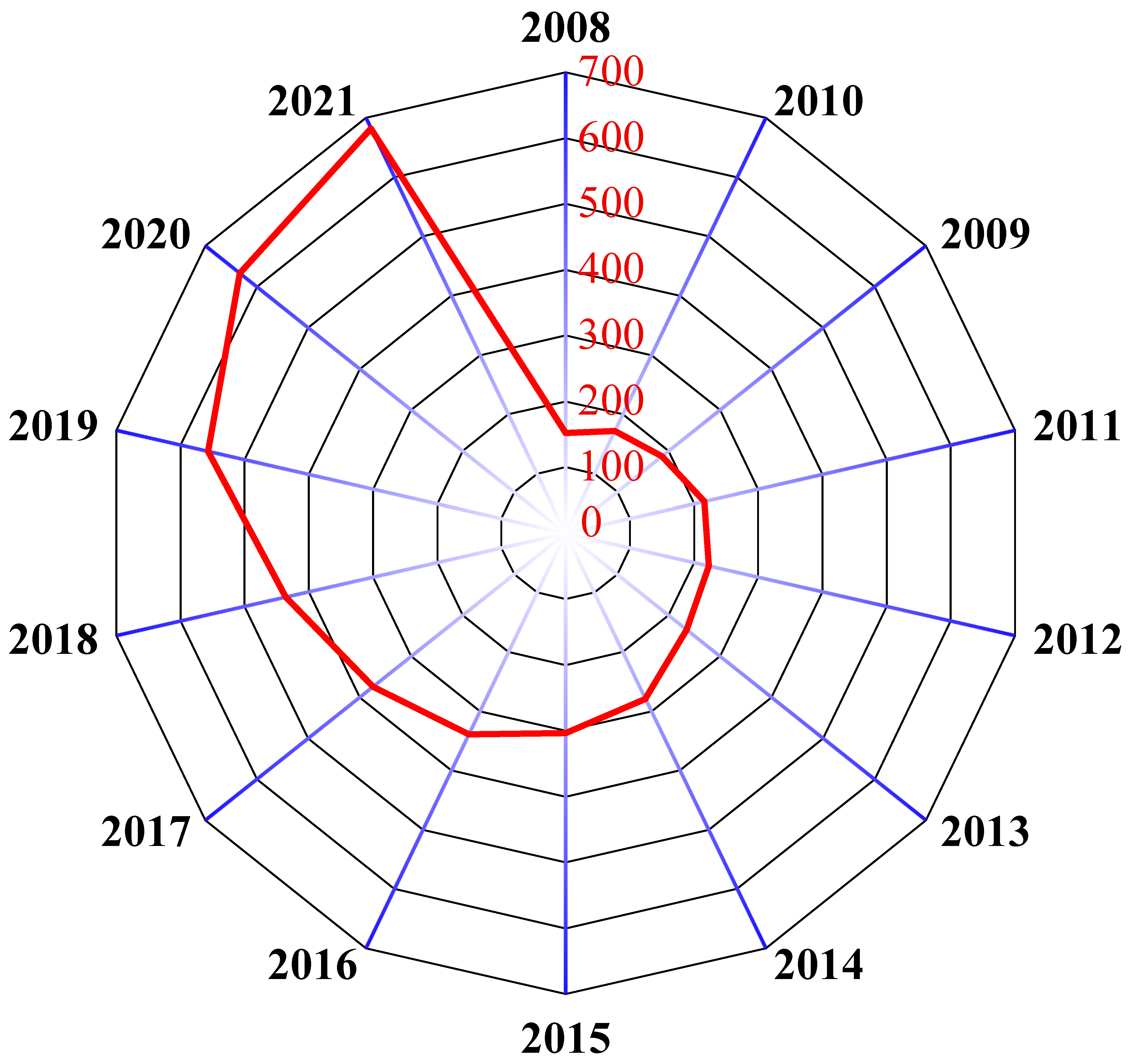
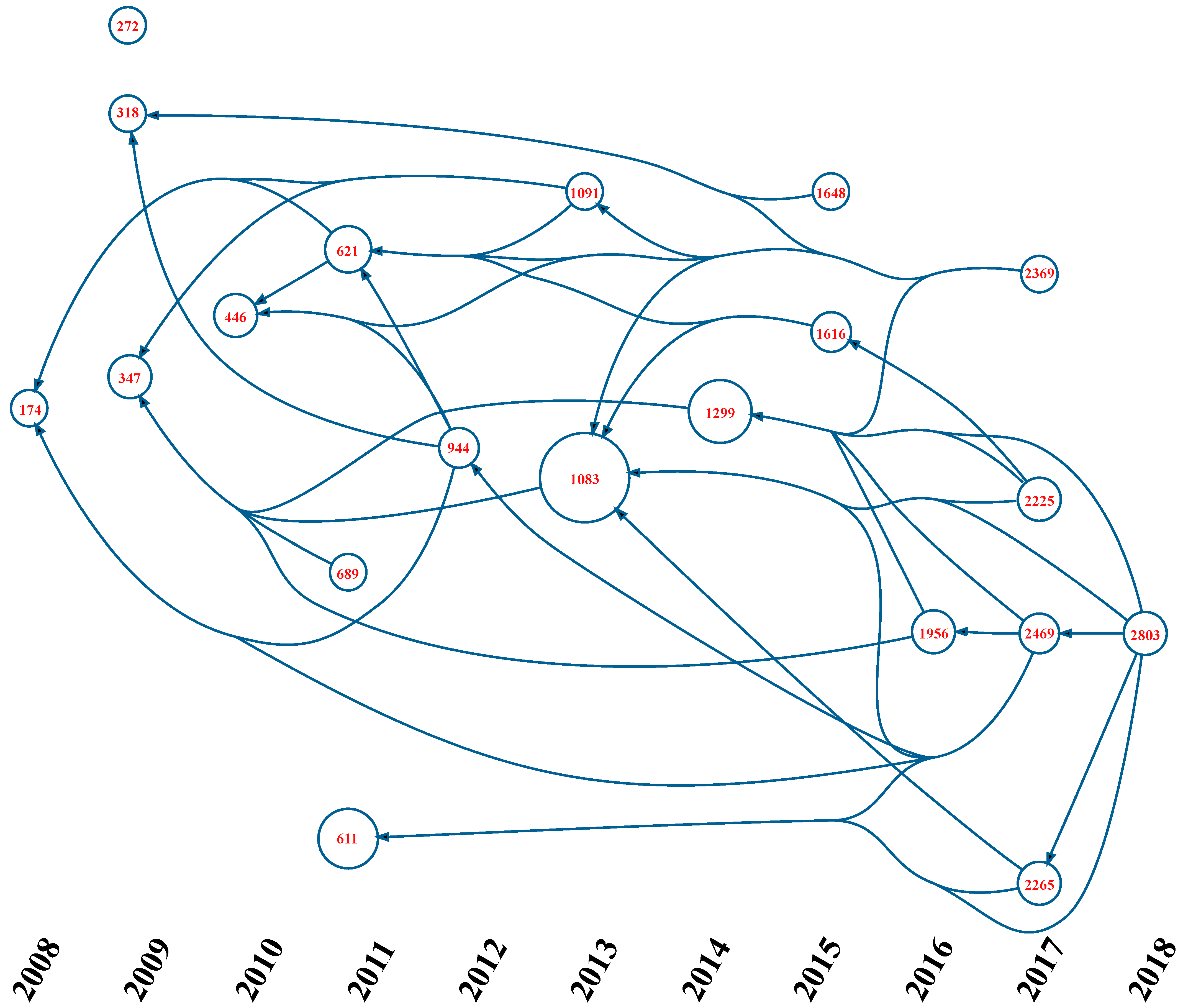
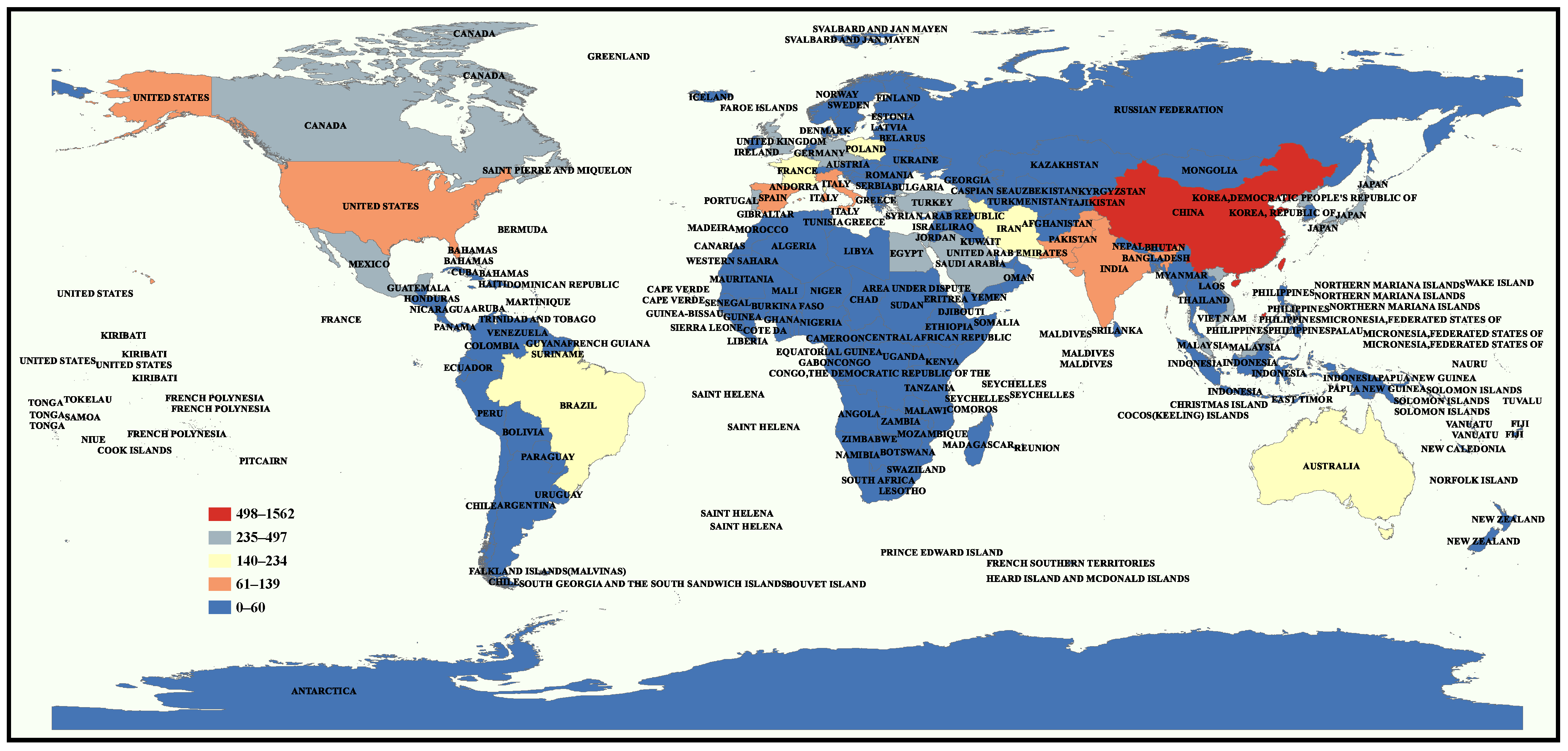
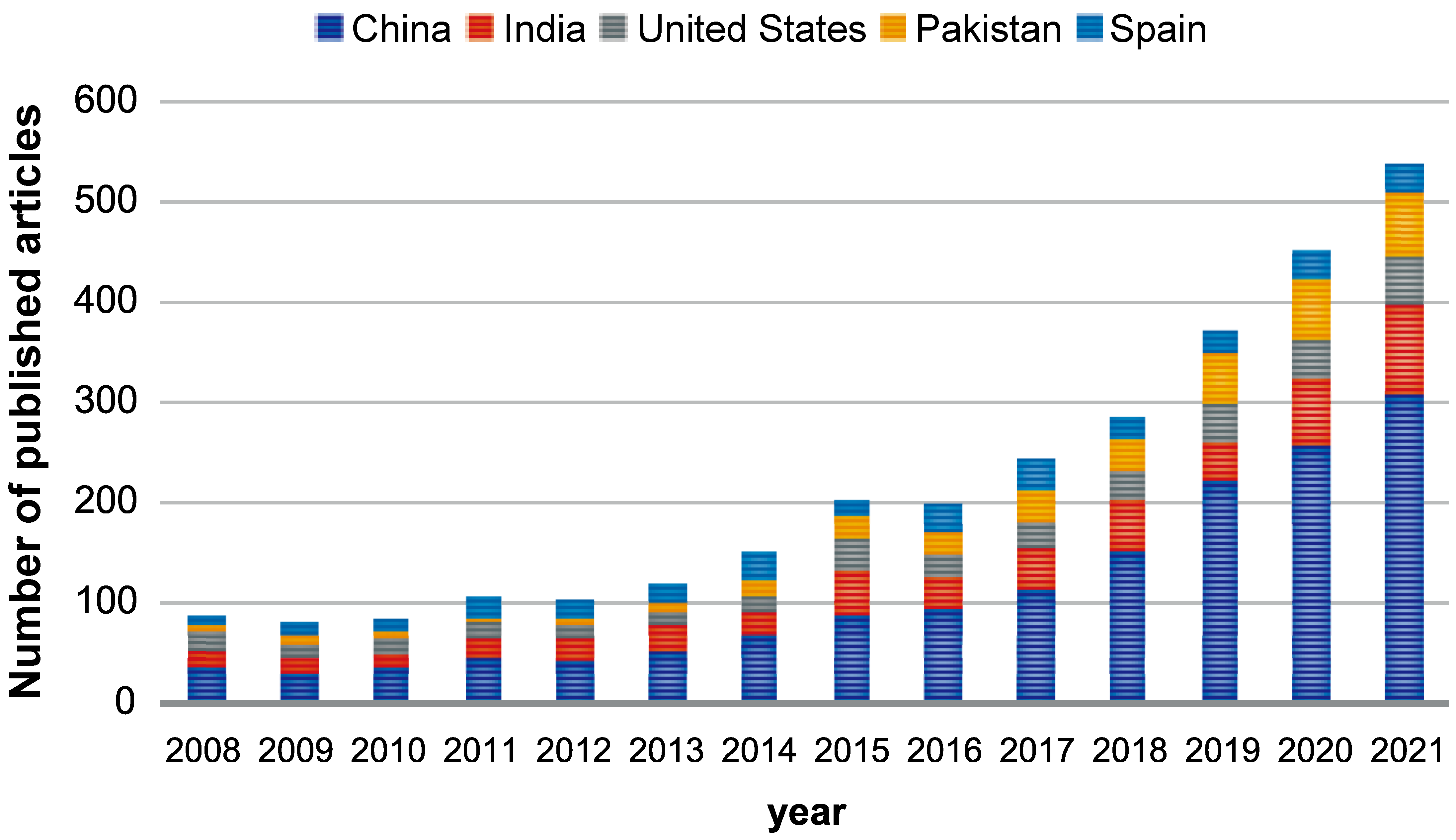
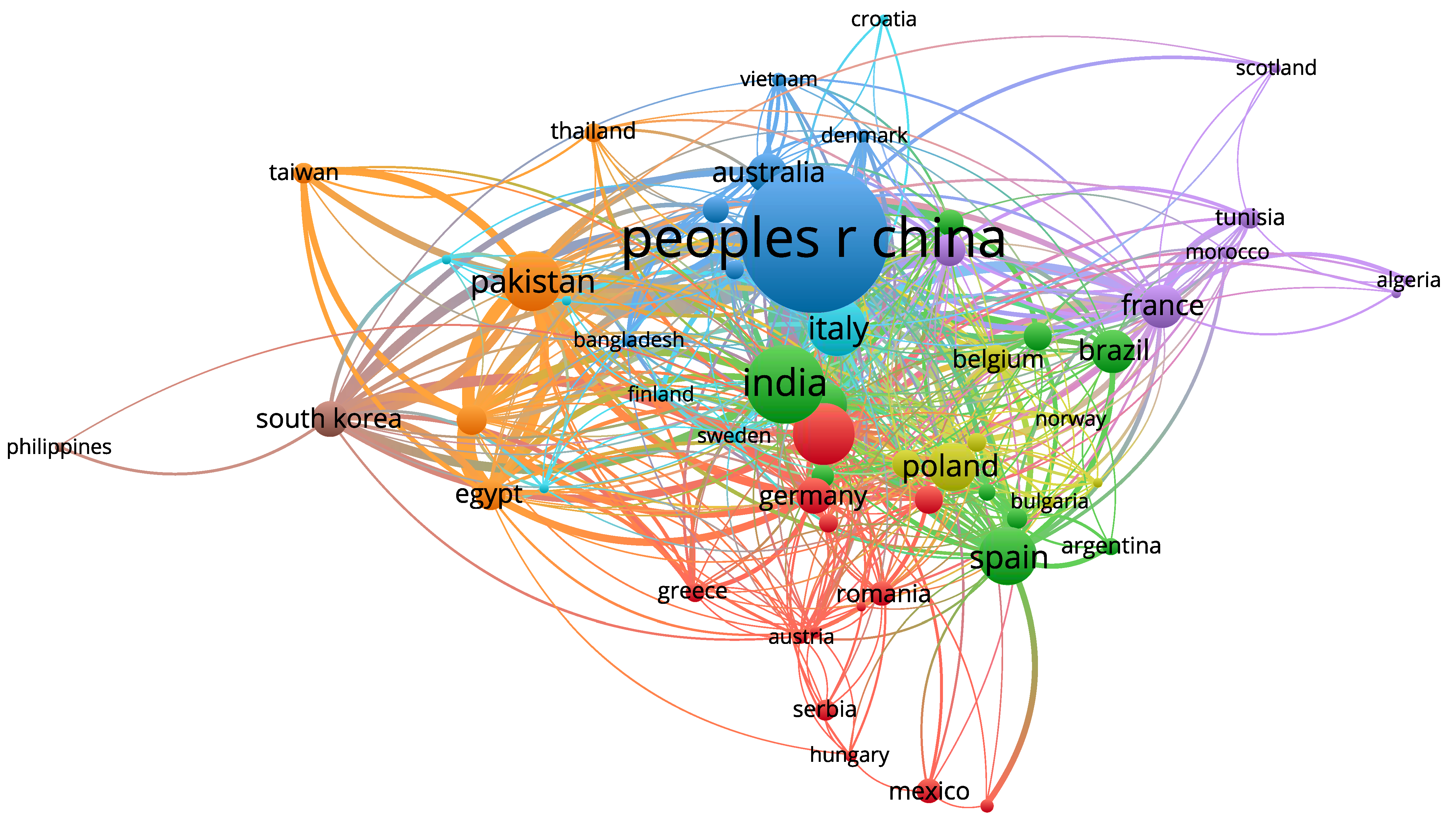
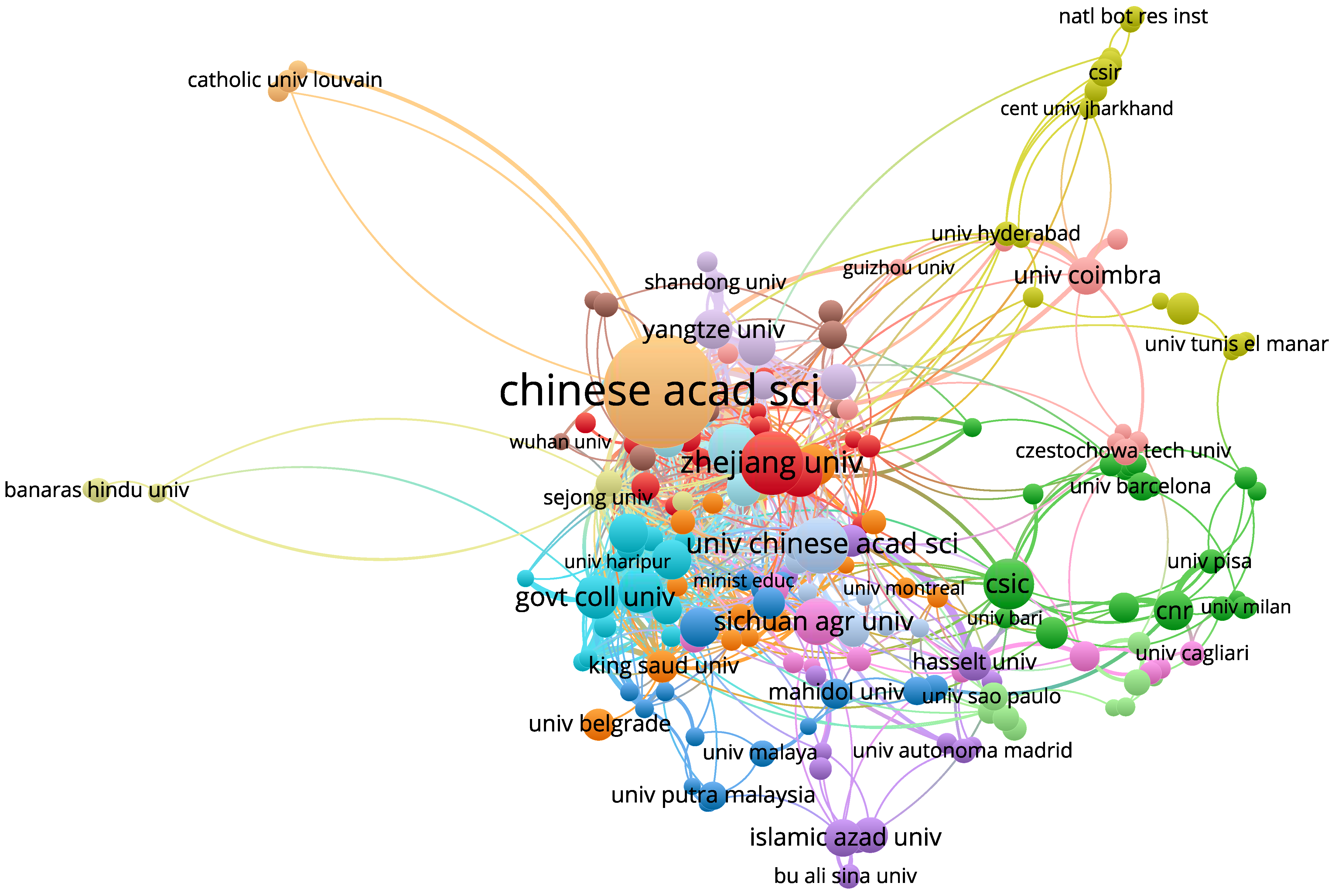
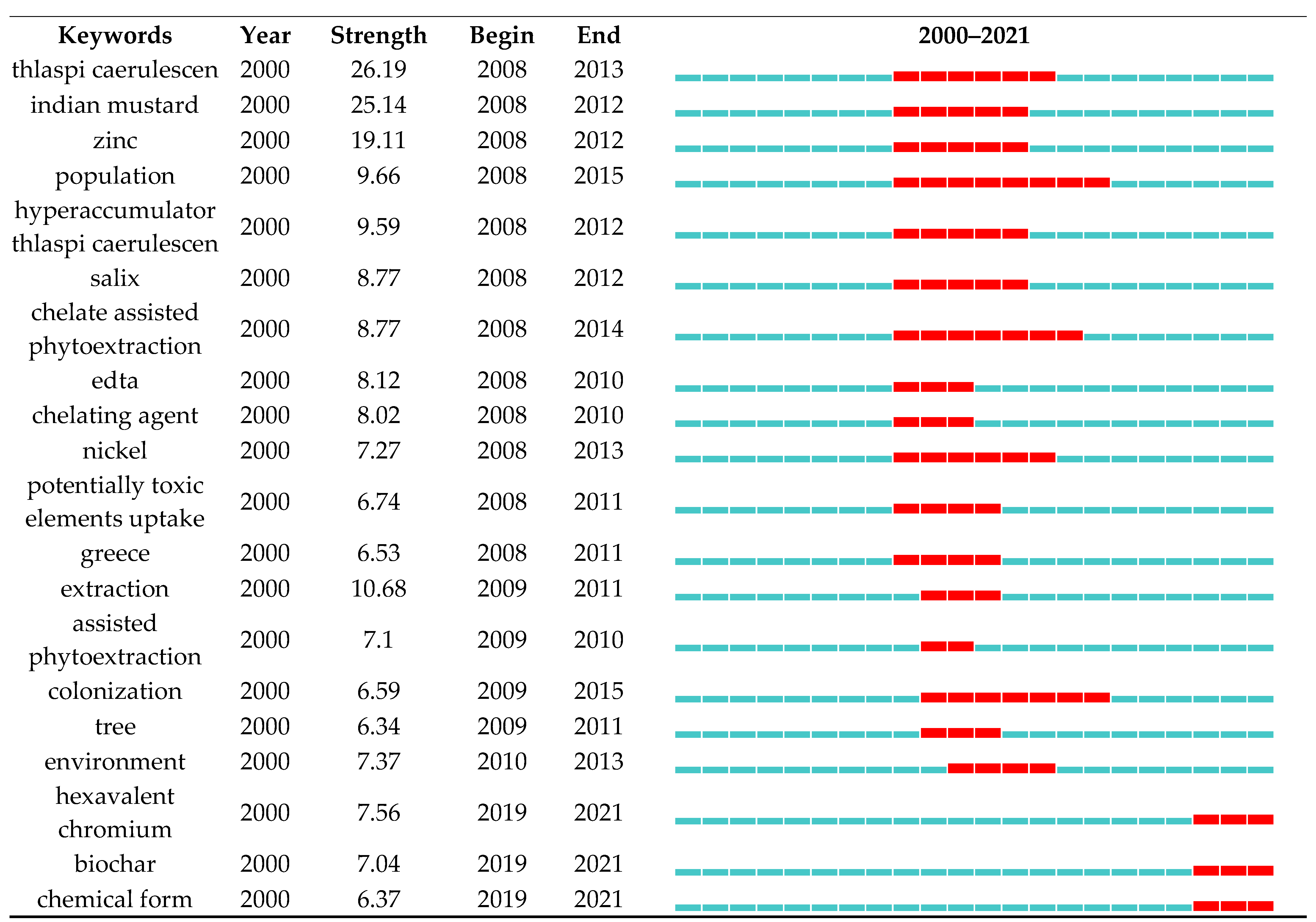
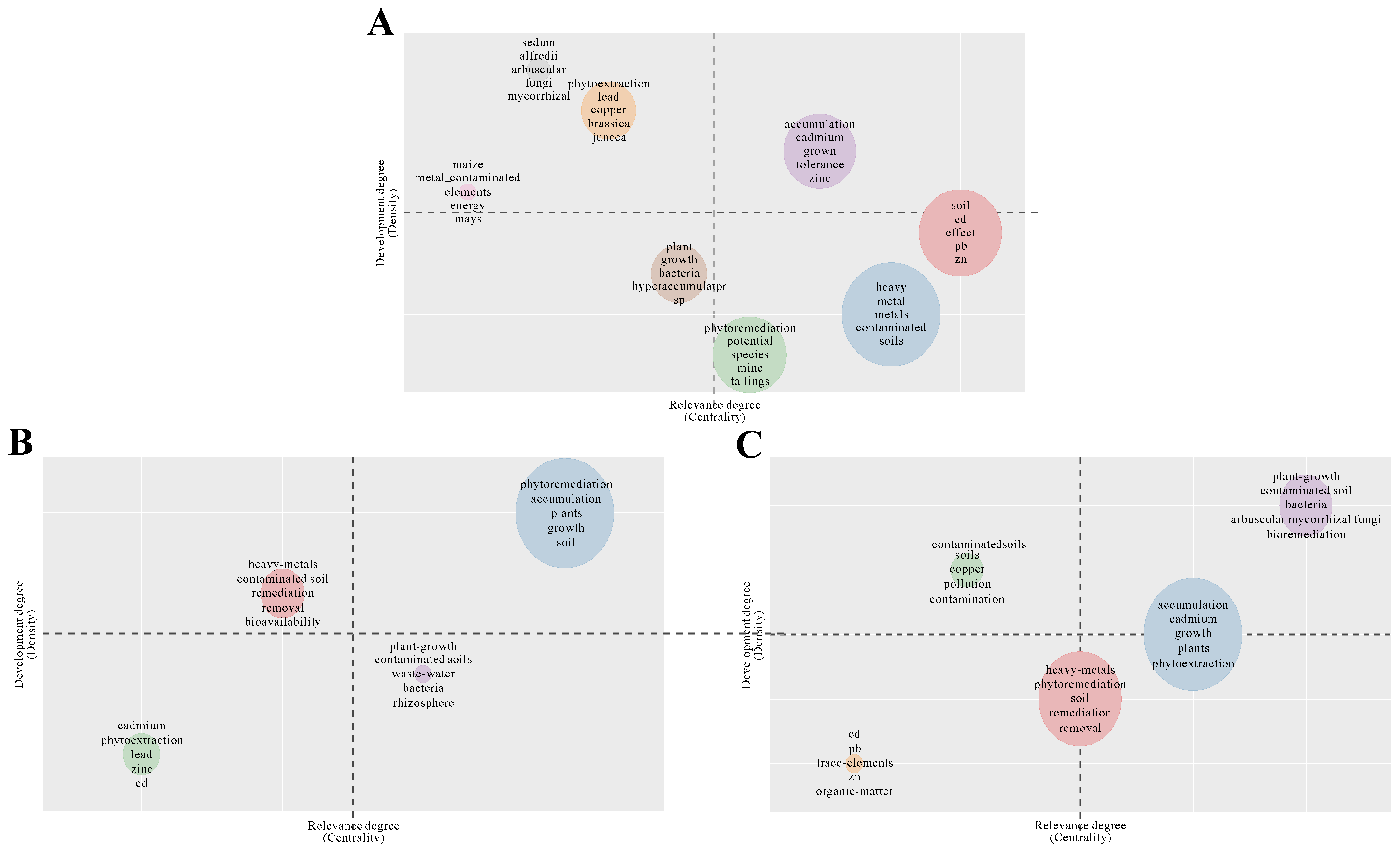
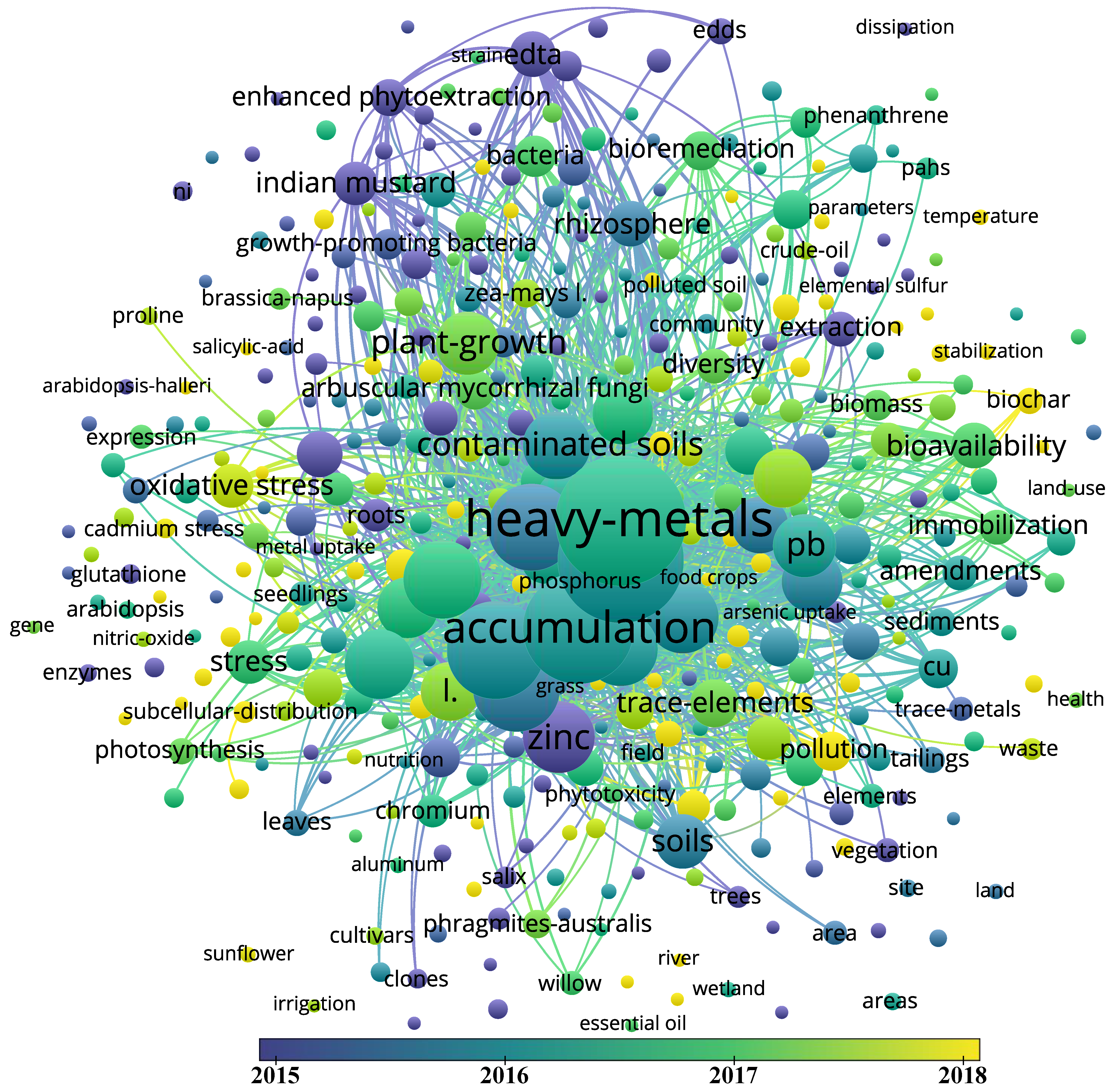
| Journal Name | ArticleNum | Proportion | IF2021 | TLCS | TGCS |
|---|---|---|---|---|---|
| Environmental Science and Pollution Research | 418 | 8.73 | 4.223 | 2019 | 7747 |
| International Journal of Phytoremediation | 395 | 8.25 | 3.212 | 1985 | 6846 |
| Chemosphere | 325 | 6.79 | 7.086 | 3517 | 14,066 |
| Ecotoxicology and Environmental Safety | 186 | 3.88 | 6.291 | 1457 | 5358 |
| Journal of Hazardous Materials | 148 | 3.09 | 10.588 | 1824 | 8537 |
| Science of The Total Environment | 135 | 2.82 | 7.963 | 849 | 4264 |
| Environmental Pollution | 124 | 2.59 | 8.710 | 990 | 4413 |
| Water Air and Soil Pollution | 119 | 2.49 | 2.520 | 322 | 2394 |
| Journal of Environmental Management | 106 | 2.21 | 6.789 | 923 | 3770 |
| Ecological Engineering | 72 | 1.50 | 4.035 | 642 | 2060 |
| Countries | Published Articles | Proportion | TLCS | TGCS |
|---|---|---|---|---|
| China | 1562 | 32.62 | 8231 | 36,602 |
| India | 497 | 10.38 | 3764 | 17,266 |
| United States | 343 | 7.16 | 2317 | 11,394 |
| Pakistan | 339 | 7.08 | 3441 | 12,773 |
| Spain | 308 | 6.43 | 1580 | 9205 |
| Italy | 284 | 5.93 | 2350 | 9765 |
| Poland | 234 | 4.89 | 931 | 4377 |
| France | 189 | 3.95 | 1602 | 6637 |
| Iran | 188 | 3.93 | 699 | 2531 |
| Brazil | 179 | 3.74 | 575 | 2995 |
| Institution | Records | Proportion |
|---|---|---|
| CHINESE ACADEMY OF SCIENCES | 322 | 6.72 |
| UNIVERSITY OF CHINESE ACADEMY OF SCIENCES (CAS) | 114 | 2.38 |
| ZHEJIANG UNIVERSITY | 111 | 2.32 |
| CONSEJO SUPERIOR DE INVESTIGACIONES CIENTIFICAS (CSIC) | 98 | 2.05 |
| COUNCIL OF SCIENTIFIC INDUSTRIAL RESEARCH (CSIR) INDIA | 95 | 1.98 |
| EGYPTIAN KNOWLEDGE BANK (EKB) | 93 | 1.94 |
| CENTRE NATIONAL DE LA RECHERCHE SCIENTIFIQUE (CNRS) | 90 | 1.88 |
| LEAGUE OF EUROPEAN RESEARCH UNIVERSITIES (LERU) | 87 | 1.82 |
| UNIVERSITY OF AGRICULTURE FAISALABAD | 80 | 1.67 |
| INRAE | 77 | 1.61 |
Publisher’s Note: MDPI stays neutral with regard to jurisdictional claims in published maps and institutional affiliations. |
© 2022 by the authors. Licensee MDPI, Basel, Switzerland. This article is an open access article distributed under the terms and conditions of the Creative Commons Attribution (CC BY) license (https://creativecommons.org/licenses/by/4.0/).
Share and Cite
Zhang, Y.-L.; He, G.-D.; He, Y.-Q.; He, T.-B. Bibliometrics-Based: Trends in Phytoremediation of Potentially Toxic Elements in Soil. Land 2022, 11, 2030. https://doi.org/10.3390/land11112030
Zhang Y-L, He G-D, He Y-Q, He T-B. Bibliometrics-Based: Trends in Phytoremediation of Potentially Toxic Elements in Soil. Land. 2022; 11(11):2030. https://doi.org/10.3390/land11112030
Chicago/Turabian StyleZhang, Yu-Le, Guan-Di He, Ye-Qing He, and Teng-Bing He. 2022. "Bibliometrics-Based: Trends in Phytoremediation of Potentially Toxic Elements in Soil" Land 11, no. 11: 2030. https://doi.org/10.3390/land11112030
APA StyleZhang, Y.-L., He, G.-D., He, Y.-Q., & He, T.-B. (2022). Bibliometrics-Based: Trends in Phytoremediation of Potentially Toxic Elements in Soil. Land, 11(11), 2030. https://doi.org/10.3390/land11112030







